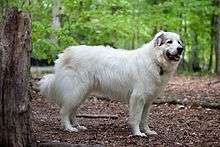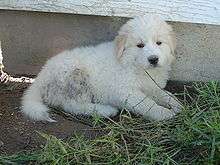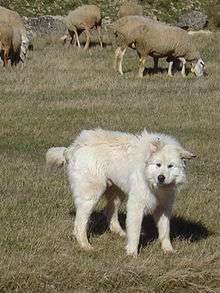Great Pyrenees
 | ||||||||||||||||||||||||||
| Other names |
Pyrenean Mountain Dog Patou Montañés del Pirineo Perro de Montaña de los Pirineos Can de Montaña de os Perinés Chien des Pyrénées Chien de Montagne des Pyrénées | |||||||||||||||||||||||||
|---|---|---|---|---|---|---|---|---|---|---|---|---|---|---|---|---|---|---|---|---|---|---|---|---|---|---|
| Common nicknames | Pyr, GP, PMD | |||||||||||||||||||||||||
| Origin | France/Spain[1] | |||||||||||||||||||||||||
| ||||||||||||||||||||||||||
| ||||||||||||||||||||||||||
| Domestic dog (Canis lupus familiaris) | ||||||||||||||||||||||||||
The Pyrenean Mountain Dog, known as the Great Pyrenees in North America, is a large breed of dog used as a livestock guardian dog. It should not be confused with the Pyrenean Mastiff.
As late as 1874 the breed was not completely standardized in appearance, with two major sub-types recorded, the Western and the Eastern.[2] They are related to several other large white European livestock guardian dogs (LGD), including the Italian Maremma Sheepdog, Kuvasz (Hungary), Akbash Dog (Turkey) and Polish Tatra or Polski Owczarek Podhalański, and somewhat less closely to the Newfoundland and St. Bernard. According to the Great Pyrenees Club of America, the Great Pyrenees is naturally nocturnal and aggressive with any predators that may harm its flock. However, the breed can typically be trusted with small, young, and helpless animals of any kind due to its natural guardian instinct.[3]
The Great Pyrenees breed has experienced a dramatic fall off in the number of U.S. AKC breed registrations from 2000 to 2010.[4] The breed was ranked at #45 in 2000 and by 2010 Great Pyrenees had dropped to #71. In 2013 the breed was ranked #69. Other large breeds in the same working group classification, Newfoundland and St. Bernard, have fared far better in maintaining their breed rankings. In 2010 Newfoundland and St. Bernard were ranked #44 and #45 respectively.
Description




They grow to 85–140 pounds (39–64 kg) and 25–32 inches (64–81 cm).[3] On average, their lifespan is 10 to 11 years.[5]
The weather resistant double coat consists of a long, flat, thick, outer coat of coarse hair, straight or slightly undulating, and lying over a dense, fine, woolly undercoat. The coat is more profuse about the neck and shoulders where it forms a ruff or mane, which is more pronounced in males so that it may fend off wolf attacks. The longer hair on the tail forms a plume. There is also feathering along the back of the front legs and along the back of the thighs, giving a "pantaloon" effect. The hair on the face and ears is both shorter and of finer texture.
The main coat color is white and can have varying shades of gray, red (rust), or tan around the face (including a full face mask), ears and sometimes on the body and tail. As Great Pyrenees mature, their coats grow thicker and the longer colored hair of the coat often fades. Sometimes a little light tan or lemon will appear later in life around the ears and face. Being a double-coated breed, the undercoat can also have color and the skin as well. The color of the nose and on the eye rims should be jet black.[6] Grey or tan markings that remain lend the French name, "blaireau", (badger) which is a similar grizzled mixture color seen in the European badger. More recently, any color is correctly termed "Badger" or "Blaireau".[7]
One singular characteristic of the Great Pyrenees is the unique double dew claws on each hind leg.[8]
Temperament
In nature, the Great Pyrenees is confident, gentle (especially with children), and affectionate. While territorial and protective of its flock or family when necessary, its general demeanor is of composure and patience and loyalty. It is a strong willed, independent and reserved breed. It is also attentive, quite fearless and loyal to its duties. The Great Pyrenees' size makes it an imposing guardian. A dog of this breed will patrol its perimeter and may wander away if left off its leash in an unenclosed space. The Great Pyrenees protects its flock by barking, and being nocturnal, tends to bark at night unless trained against such behavior.[8]
The Great Pyrenees can be slow to learn new commands, slow to obey, and somewhat stubborn to train. For this reason the breed is ranked #64 (out of 79 ranks covering 131 breeds) in Stanley Coren's The Intelligence of Dogs. Despite this relative stubbornness, it is quite unusual for the Great Pyrenees to become aggressive or turn on its master. It is wary of strangers if the person is not allowed in the house, but will settle down if the owner of the dog seems comfortable with the stranger. This dog was originally bred to be a livestock guard dog, and can still be found doing that job on farms and ranches.
Upkeep
When kept as a house pet, the Great Pyrenees' coat needs brushing once or twice a month. The breed needs moderate exercise but tends to be somewhat lazy, especially in warm weather. They particularly enjoy cold weather and snow. Like similar breeds, some Great Pyrenees tend to drool, especially with exercise.[8] Great Pyrenees need to have their nails clipped often to avoid damage. This breed also needs to have their teeth and ears cleaned regularly to prevent infection. [9]
History
The Great Pyrenees is a very old breed that has been used for hundreds of years by shepherds, including those of the Basque people, who inhabit parts of the region in and around the Pyrenees Mountains of southern France and northern Spain (specifically Aragon and Navarre).[10]
Varro, a Roman author who lived in the first century BC, wrote in his treatise of rural economy "De re rustica" in 37 BC.:
"The dog is essential for those who raise animals for wool. It is the guardian of livestock in general but is the natural defender of the sheep and goats. The wolf lurks constantly and we oppose it with the dogs"... "As for its appearance, choose those who are well-trained, large size, with black or red eyes, the nose of the same color, red lips pulling to black, not too collected, nor too pendants"... "It is equally essential that the dogs have strong head, long, floppy ears, wide and short neck, thighs and rights more inwardly turned than out, wide legs, fingers apart, hard nails and bent, spine nor projection nor convex, bushy tail, sonorous voice, good match muzzle and preferably with white hair so that it can be easily distinguished from wild animals at night."
.jpg)
One of the first descriptions of the breed dates from 1407, Fray Miguel Agustín, "prior" of the Temple who lived between 1560 and 1630, published in 1617 in Catalan (the first edition appeared in Spanish in 1622), a book which he called Libro de los secretos de la agricultura, casa de campo y pastoril. It gives the reasons why shepherds prefer white puppies, excluding those born with spots of dark color. Relates the friar: "The wool cattle dogs should not must be so big or so heavy as those of the guard of the house, but strong and sturdy, lightweight and ready to combat and fight and for run, because they have to make saves and guard against wolves and hunt them down if those take a cattle... These should be white, so that the shepherd can easily see when these run after the wolf and know them in the evening and the morning."[11]
From 1675 the breed was a favorite of The Grand Dauphin and other members of the French aristocracy.[12]
In the mid-19th century, the breed was not homogenized. According to the article published on February 20, 1874 in the journal "Acclimatation" and written by the canine expert Kermadec, says:
"There in the Pyrenees various types of large dogs, called Mountain Dogs, and among other, two very different varieties:
-One, We might designate with the name "Dog of the Western Pyrenees," particularly widespread around Bagneres-de-Bigorre; have thick snout, hanging lips, rounded ears, a little curly coat black and white, seems to be largely the strain of large dogs designated with the name Terra-Nova Dogs, widespread throughout France.
-The Second type is the "Dog of the Eastern Pyrenees" is large, very slender shape, pointed snout, pointy ears and falls, soft, silky and abundant coat, a complete white snow color. In some cases there is a blackish band around the eyes, but often it is completely white... It was extended once in the Republic of Andorra and part of Spain, but in Andorra is completely extinguished. It might still exist in the mountains of Spain."[13][14][15]

Spread
It is possible that Venezuelan Mucuchies breed descend from the Great Pyrenees, other Spanish breeds, and other few more breeds, that could be introduced in 16th century by Spanish conquistadors.[16]
The real spread of the Great Pyrenees out of its mountains developed in the 19th century with the birth of Romanticism. This breed, first appreciated for its beauty and poise, and then by its innate temperamental qualities, gained fame in the rest of Europe. Great Pyrenees were introduced in America by General Lafayette in 1824. In Australia they were introduced in 1843 to save herds on a farm in Hamilton.
By the early 19th century there was a thriving market for the dogs in mountain towns, from which they would be taken to other parts of France. The dog was developed to be agile in order to guard sheep on steep, mountainous slopes.[8]
In popular culture
- Belle, from Cécile Aubry's Belle et Sébastien novel is a Great Pyrenees.
- The 2004 film Finding Neverland used a Great Pyrenees to represent J. M. Barrie's Landseer Newfoundland dog.
- In the television series, King of Queens, a Great Pyrenees is a recurring customer of Holly the dog walker.
- In the 1965 film Those Magnificent Men in their Flying Machines, a Great Pyrenees is the household dog at the Lord Rawnsley estate.
- In the Marx Brothers' Horse Feathers, a Great Pyrenees appears in the dog catcher's wagon.
- In the Korean variety show Happy Sunday - 1 Night 2 Days, Sang Geun, a Great Pyrenees, is the mascot of the show and recently appointed as "Nation's Pet".
- A popular Korean singer, Hero Jaejoong from TVXQ owns a Great Pyrenees named Vick.
- In the 2009 Disney movie Santa Buddies, a Great Pyrenees puppy named Puppy Paws is the leading character.
- Barry Gibb of the Bee Gees owned a Great Pyrenees named Barnaby who was in their television movie Cucumber Castle and the video for their song "Lonely Days".
- In the Jim Carrey movie Dumb and Dumber, a Great Pyrenees appears in the dog-mobile.
- Webcomic artist Jeph Jacques owns a Great Pyrenees named Shelby, who has appeared in his webcomic Questionable Content on occasion. He appears almost exactly the same as Mr. Tadakichi of anime fame (see below).
- In Hanazakari no Kimitachi e, the male lead had a Great Pyrenees named "Yu Ci Lan" for a pet.
- Many Japanese manga and anime series have dogs that are either this breed or based on its appearance:
- Alexander from Fullmetal Alchemist is a large Great Pyrenees who is the pet of Shou Tucker. Alexander is later combined with Shou's daughter Nina to form a Chimera.
- Tadakichi-san (Mr. Tadakichi in the English version), owned by Chiyo Mihama in Azumanga Daioh
- Akamaru from Naruto is Kiba Inuzuka's pet Great Pyrenees.
- Cherry, owned by Minami Iwasaki in Lucky Star.
- Baron from Noein: To Your Other Self is Haruka Kaminoga's pet Great Pyrenees.
- Peace, a dog belonging to one of Ashirogi Muto's assistants appears in Bakuman.
- The Japanese series Ginga Densetsu Weed features a Great Pyrenees named Hiro, who is nicknamed the "The Castrator", due to his signature attack of neutering his opponents.
- In the book Between Mom and Jo by Julie Anne Peters, the family takes in a stray Great Pyrenees.
- In the book Futures and Frosting by Tara Sivec, Carter's parents buy him, Claire and Gavin a Great Pyrenees puppy. Claire exaggeratingly describes it as a "900-pound animal", "almost the same size as Gavin" and "looks like a polar bear".
- The logo of the Sea Dog Brewing Company represents the founders' late Great Pyrenees.[17]
- During the live simulcast of the Stephanie Miller Show radio show on Free Speech TV, Stephanie's two Great Pyrenees, Max and Fred, are often seen on camera and are a subject of discussion.
- In 2014 a Great Pyrenees known as Duke the Dog became mayor of a small Minnesota town Cormorant.[18][19][20]
See also
- Akbash Dog
- Kuvasz
- Maremma Sheepdog
- Mountain dog
- Mucuchies
- Polish Tatra Sheepdog
- Pyrenean Mastiff
- Slovak Cuvac
References
- ↑ "Great Pyrenees Connection". greatpyrenees.com.
- ↑ Durr, Mark. Dog's Best Friend: Annals of the Dog-Human Relationship - 2004 Page 161.
- 1 2 "Great Pyrenees Club of America: Livestock Guardian Dog". Great Pyrenees Club of America. 2010-01-10. Archived from the original on 2006-02-09. Retrieved 2012-03-17.
- ↑ "AKC Dog Registration Statistics". American Kennel Club. Retrieved 2012-03-17.
- ↑ "Great Pyrenees Club of America's 2006 Health Survey Results" (PDF).
- ↑ "American Kennel Club Profile". Akc.org. Retrieved 2012-03-17.
- ↑ "A description of the breed". Clubs.akc.org. Retrieved 2012-03-17.
- 1 2 3 4 Coile, D. Caroline (2005). Encyclopedia of Dog Breeds, second edition. Barron's. ISBN 0764157000.
- ↑ Club, American Kennel. "Great Pyrenees Health & Care Information". www.akc.org. Retrieved 2016-09-16.
- ↑ "Early History of the breed". Clubs.akc.org. Retrieved 2012-03-17.
- ↑ Online book "Libro de los secretos de agricultura, casa de campo y pastoril" written by Fray Miguel Agustín. 1622
- ↑ "Great Pyrenees Connection-Great Pyrenees Colors". Greatpyrenees.com. Retrieved 2012-03-17.
- ↑ Pyrenean Institute of the Great Pyrenees website
- ↑ EL GOS DE MUNTANYA DELS PIRINEUS, GARANT DE LA BIODIVERSITAT PIRINENCA (PDF; 1.6 MB)
- ↑ "El Perro de Montaña de Los Pirineos" website of the Club of the Great Pyrenees in Spain
- ↑ "Mucuchies Information and Pictures", dogbreedinfo.com
- ↑ "About The Sea Dog Brewing Company". seadogbrewing.com.
- ↑ "Duke The Dog Elected Mayor In Cormorant, Minn.". cbslocal.com.
- ↑ "This Dog Was Elected The Mayor Of A Small Town In Minnesota". BuzzFeed.
- ↑ Duke the dog. Mayor of Cormorant MN. YouTube. 16 August 2014.
External links
| Wikimedia Commons has media related to Pyrenean Mountain Dog. |
- Great Pyrenees at DMOZ
- Great Pyrenees Library : interesting and useful articles on breeding, behavior, livestock guardians, Great Pyrenees rescue and medical information
- GreatPyr.com : Great Pyrenees Information & Resources. Photo Gallery, Forums, and Breed Information
- Great Pyrenees Connection: Great Pyrenees breed information, photographs, history of the breed in France and the Netherlands, links to international Great Pyrenees breeders and Great Pyrenees clubs
- Livestock Guardian Dog Association